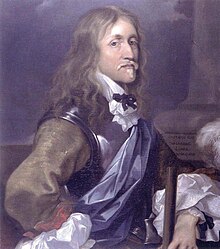Gustav Gustavson
Gustav Gustavson , from 1637 von Wasaburg ( Swedish af Vasaborg ), from 1647 Count von Nystad (born April 24, 1616 in Stockholm , † October 25, 1653 in Wildeshausen ) was an illegitimate son of King Gustav II Adolf , a Swedish military leader in his thirties War , Reichsrat and from 1633 to 1648 administrator of the bishopric of Osnabrück .
Live and act
Gustav Gustavson came from a liaison between Gustav Adolf and his Dutch mistress Margareta Slots or Margarethe Cabeliau. At the age of ten he was enrolled at Uppsala University. In 1630 he went to Gustav Adolf in Germany and enrolled on August 6, 1632 at the University of Wittenberg , together with his court master ( praefectus morum ) Hermann Meier von Münzenbrock. In October 1632 he was given the honorary title of rector magnificus of the university. However, he did not stay long, but went to the Swedish army. In 1633, at the age of seventeen, he distinguished himself at the Battle of Oldendorf and then commanded the Swedish troops that occupied the Osnabrück bishopric. He expelled Bishop Franz Wilhelm von Wartenberg and, after pressure from the Swedish Imperial Council, had himself declared administrator by the cathedral chapter in January 1634 . Like the prince-bishops, he resided at Iburg Castle , where his portrait can still be seen today in the row of prince-bishops. The inscription notes that he presided over the diocese in the turmoil of war while Bishop Franz Wilhelm was still alive, from January 1634 to the end of 1650 . From 1643 he resided in Vörden .
In 1637 he was raised to the nobility as von Wasaburg ( af Vasaborg ). Queen Christina made her half-brother Count of Nystad in 1647 . At the same time, the family was accepted into the count's class of the knight's house under number 6 .
When the city of Osnabrück was declared a neutral city in 1643 as part of the preparations for the peace treaty, he had the Swedish troops withdrawn. As a result of the Peace of Westphalia , he also had to vacate the monastery area, which dragged on until 1650. He was promised a financial compensation of 80,000 thalers, which was to be raised in equal parts by the prince-bishop and the three estates of the bishopric, and he received the now Swedish rule of Wildeshausen and Huntlosen , where he had a castle built.
In 1645 he became governor of Estonia and in 1646 Swedish councilor. 1649/1650 he applied unsuccessfully for the position as admiral of the Swedish fleet. He returned to Germany and died in Wildeshausen. His body was transferred to Stockholm in August 1654 and buried in its own burial chapel in Riddarholmskyrkan .
He was married to Anna Sofia von Wied-Runkel (1616–1694), the sister of Count Friedrich III. from Wied.
Of the couple's children, Gustav Adolf (1653–1732) also became an officer and continued the Counts of Wasaburg . He was married to Angelika Catharina von Leiningen-Westerburg . The daughter Kristina / Christina (1644–1709) married Wolmar Wrangel .
See also
literature
- Ludwig Hoffmeyer: History of the city and the administrative district of Osnabrück in pictures. Rackhorst, Osnabrück 1904, pp. 92-99
- Vasaborg . In: Theodor Westrin, Ruben Gustafsson Berg, Eugen Fahlstedt (eds.): Nordisk familjebok konversationslexikon och realencyklopedi . 2nd Edition. tape 31 : Ural vertex . Nordisk familjeboks förlag, Stockholm 1921, Sp. 756 (Swedish, runeberg.org ).
Web links
Individual evidence
- ↑ See the register with Bernhard Weissenborn: Album Academiae Vitebergensis - Younger Series Part 1 (1602–1660). Magdeburg 1934, p. 365
- ^ Ulrich Bracher: Gustav Adolf of Sweden: a historical biography. Stuttgart, Berlin, Cologne, Mainz: Kohlhammer 1971
- ↑ Susanne Tauss: The Knights' Hall of the Iburg: on the Prince-Bishop's Residence of Franz Wilhelm von Wartenberg: Contributions to the scientific conference from October 7th to 9th, 2004 at Iburg Castle. (Publication series Kulturregion Osnabrück of the Landschaftsverband Osnabrück 26), Göttingen: V&R unipress 2007 ISBN 978-3-89971-279-7 , p. 359 and plate 82
- ↑ Christian funeral sermon about the early Eylen from this evil life of Des ... Mr. Gustav / Graffen zu Wasaburgk ...: Which in the most deviated year 1653. fell asleep on the 25th day of the month of Octobris ... / And as the dead body on 4th Aug. Anno 1654. after Stockholm… was removed / kept in the parish churches of Hundlosen By M. Meinhard-Molano, Pastore Prim: zu Wildeshausen / and the Ministerii Seniore. Oldenburg: Printed by Henrich-Conrad Zimmer / HochGräffl: bestalt: Buchdrucker there, 1654 ( 23: 266575T in VD 17. )
| personal data | |
|---|---|
| SURNAME | Gustavson, Gustav |
| ALTERNATIVE NAMES | Gustavsson, Gustav; Vasaborg, Gustav Gustavson af; Wasaburg, Gustav Gustavson von; Nyborg, Gustav Gustavson Count of |
| BRIEF DESCRIPTION | illegitimate son of King Gustav Adolf; Swedish military leader, administrator of the Principality of Osnabrück |
| DATE OF BIRTH | April 24, 1616 |
| PLACE OF BIRTH | Stockholm |
| DATE OF DEATH | October 25, 1653 |
| Place of death | Wildeshausen |

